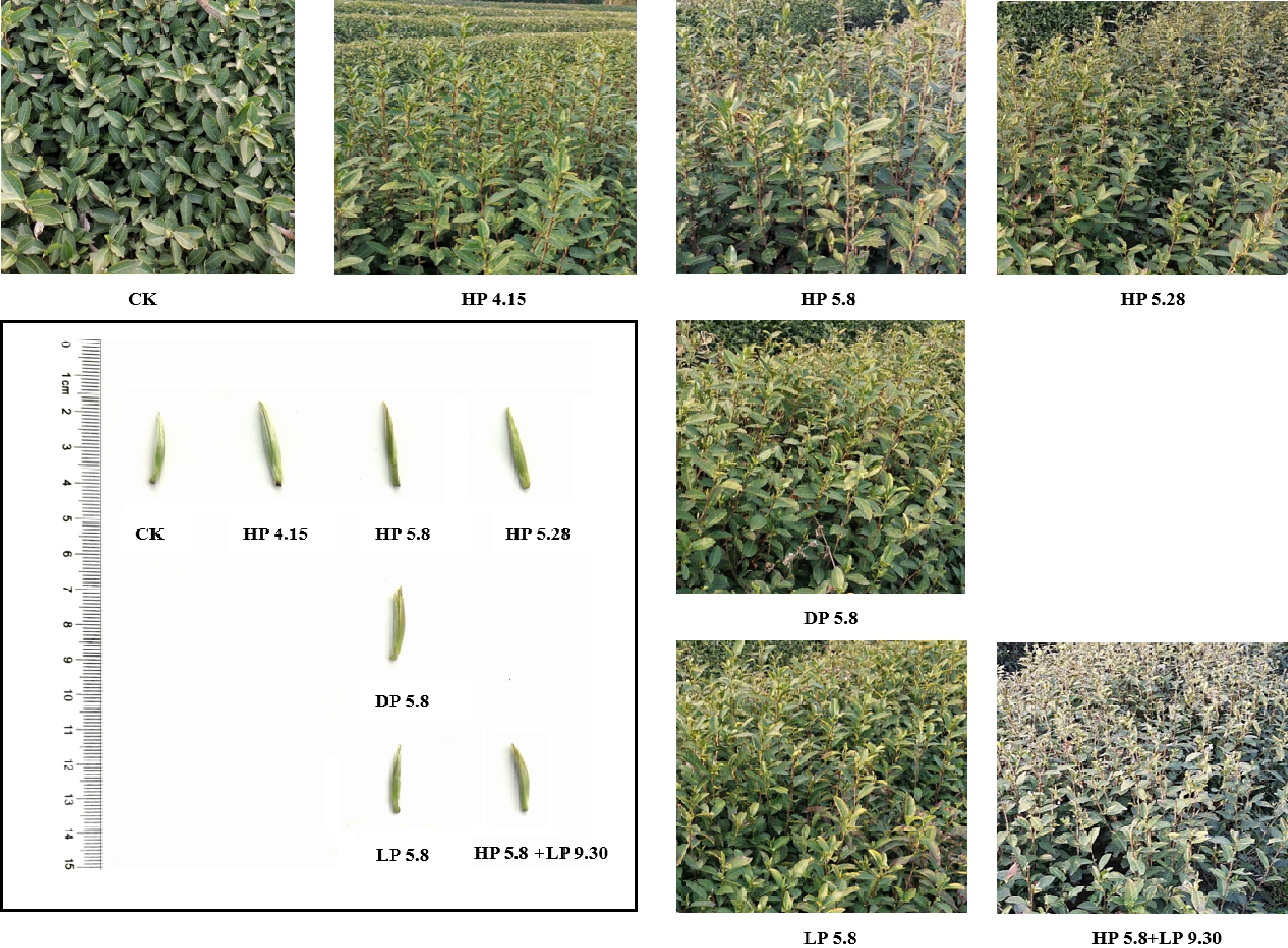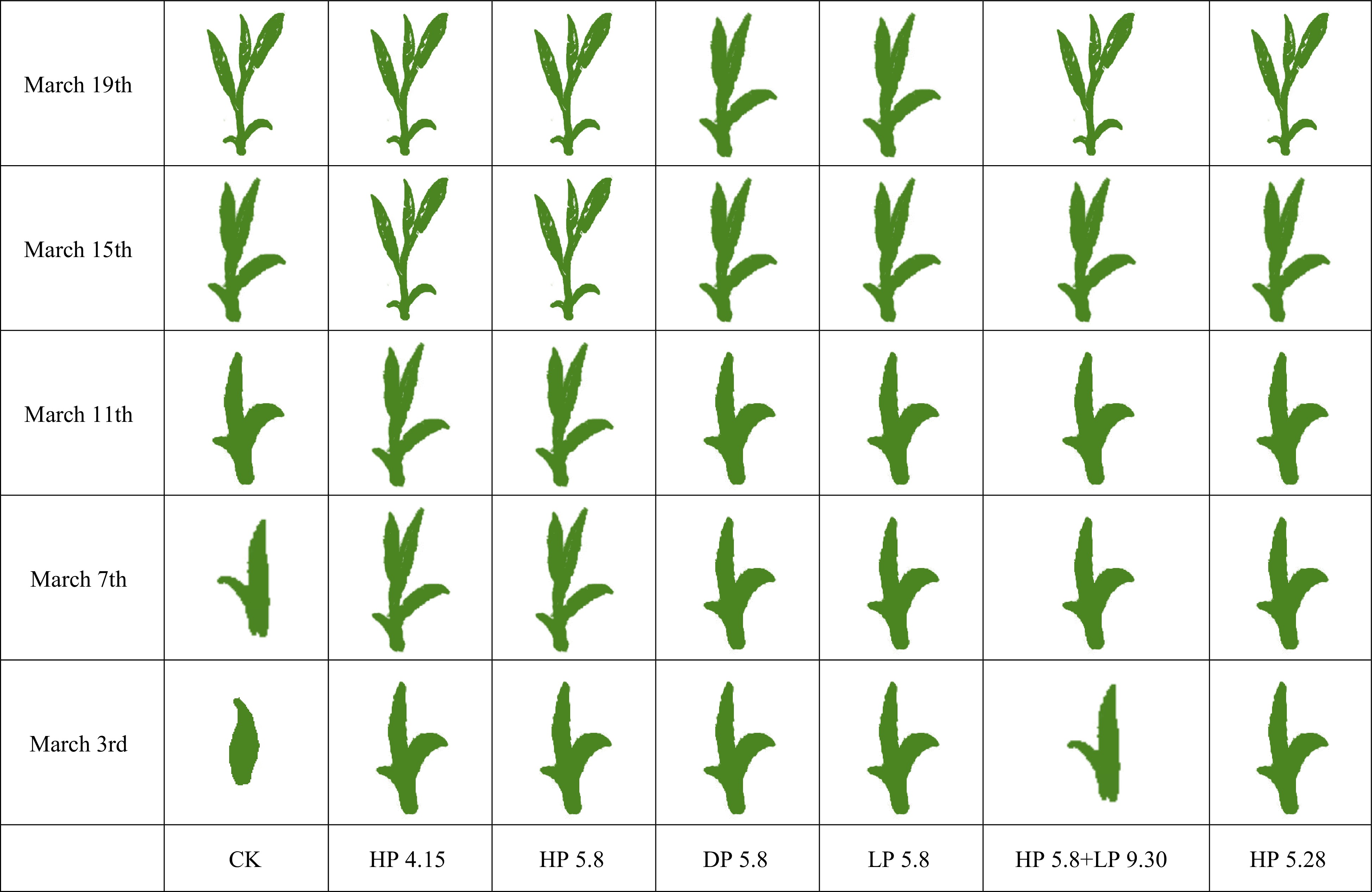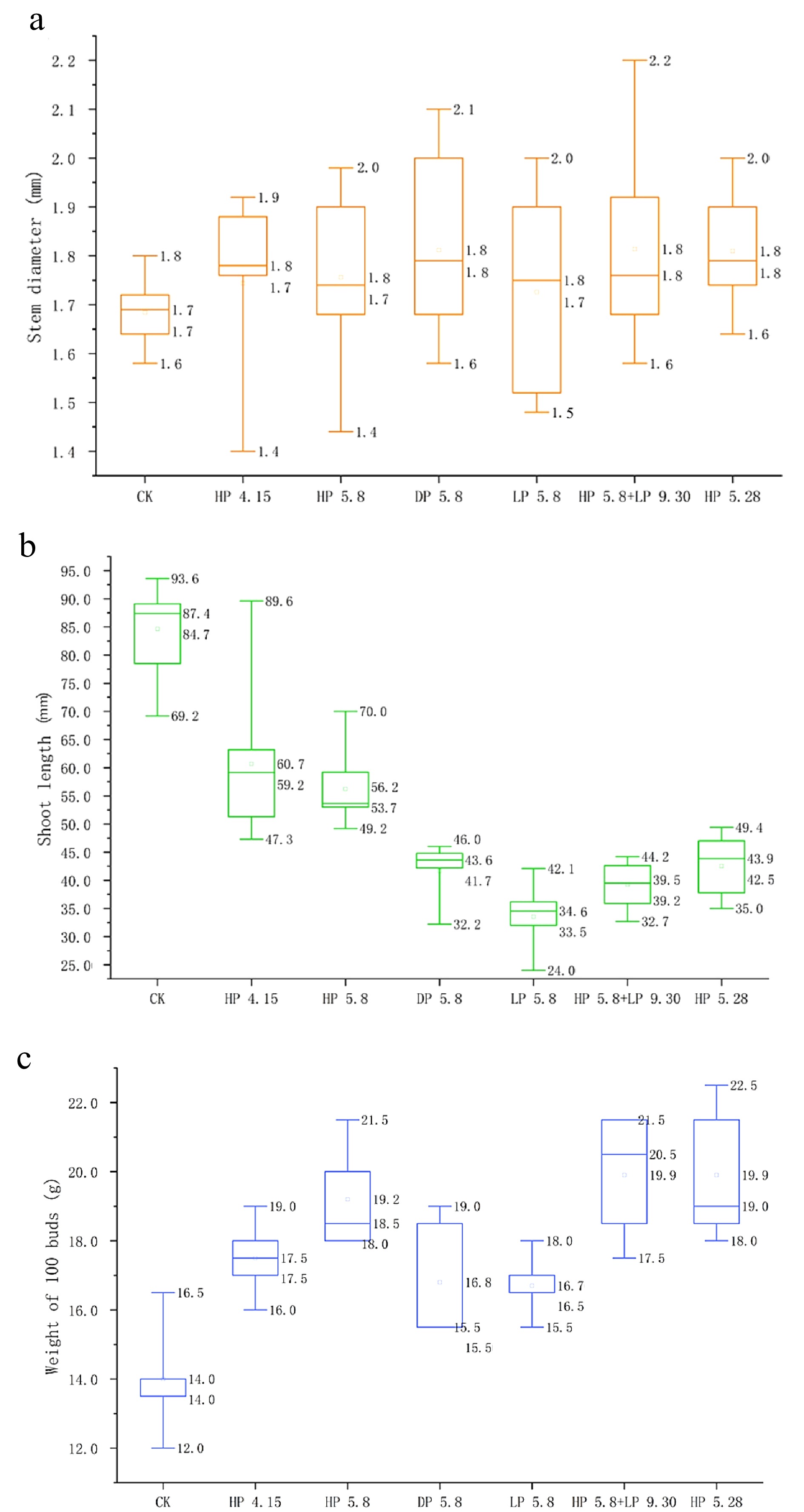-

Figure 1.
The effects of different pruning treatments on the spring shoots and buds in the following year.
-

Figure 2.
The developmental stage of young tea shoots during the following spring after different pruning treatments. The early development of young tea shoots can be divided into five characteristic stages: sprouting, first fish leaf expansion, second fish leaf expansion, one leaf and one bud, as well as two leaves and one bud.
-

Figure 3.
The box plots of (a) stem diameter, (b) shoot length and (c) weight of 100 buds of young tea shoots in the following year after different pruning treatments. Stem diameter was measured in the middle of the third internode from the apical bud; shoot length refers to the length from the base of stem to the top of apical bud; weight of 100 buds was weighted at the stage of one bud and two leaves. All the parameters were measured at the stage of two leaves and one bud on March 22nd, 2021.
-

Figure 4.
The transcriptome profiles of the buds in the spring of following year after different pruning treatments. (a) PCA analysis, (b) DEG numbers, (c) significantly enriched KEGG pathways of DEGs. The number of replicates is three.
-

Figure 5.
The heatmaps of DEGs in the fresh tea leaves under different pruning treatments. (a) Plant–pathogen interaction, (b) plant hormone signal transduction, and (c) circadian rhythm.
-
Phytohormones* CK HP 4.15 HP 5.8 DP 5.8 LP 5.8 HP 5.8+LP 9.30 HP 5.28 ABA 1,711.44 ± 42.13d 4,566.48 ± 172.96bc 4,999.26 ± 68.79b 4,775.51 ± 160.84b 4,084.18 ± 321.61c 4,179.84 ± 119.90c 6,106.79 ± 325.79a GA1 25.57 ± 1.57e 43.56 ± 1.71d 291.55 ± 10.69a 79.52 ± 7.27c 41.83 ± 5.69d 115.95 ± 2.66b 25.21 ± 3.20e GA3 20.86 ± 1.63e 35.75 ± 1.54d 206.08 ± 5.50a 75.50 ± 4.34c 24.65 ± 0.58e 98.14 ± 1.14b 19.89 ± 2.13e IAA 68.24 ± 3.58e 182.68 ± 13.87c 649.69 ± 28.48a 166.03 ± 5.40c 201.34 ± 10.09c 249.02 ± 4.70b 123.56 ± 10.14d tZ 96.59 ± 13.58e 402.32 ± 20.41d 2,886.62 ± 111.01a 854.40 ± 40.79c 202.24 ± 2.20e 1,470.30 ± 62.10b 65.58 ± 5.76e JA 2,273.34 ± 255.23d 6,399.88 ± 342.04a 4,590.13 ± 191.45bc 4,508.79 ± 126.17c 5,220.94 ± 203.86b 5,035.13 ± 47.06bc 2,191.14 ± 136.94d tZR 32.19 ± 5.46f 547.40 ± 9.98d 3,859.40 ± 275.33a 1,253.42 ± 79.85c 353.60 ± 21.47de 1,811.79 ± 83.16b 146.55 ± 6.70ef Melatonin 37.22 ± 1.69f 214.42 ± 3.56d 294.47 ± 16.14c 403.89±22.60b 79.92 ± 3.34e 516.89 ± 7.86a 85.58 ± 1.43e * ABA: abscisic acid; GA1: gibberellin A1; GA3: gibberellin A3; IAA: indole-3-acetic acid; JA: jasmonic acid; tZR: trans-zeatin-riboside; tZ: trans-zeatin.
Data with different alphabetic letters (a, b, c, d, e, f) in a same row were significantly different at p < 0.05.Table 1.
The contents of phytohormones in the fresh tea leaves the following spring after different pruning treatments (pg/g).
-
Compounds* CK HP 4.15 HP 5.8 DP 5.8 LP 5.8 HP 5.8+LP 9.30 HP 5.28 GC 0.56 ± 0.01a 0.48 ± 0.01c 0.51 ± 0.01b 0.46 ± 0.01d 0.48 ± 0.01cd 0.50 ± 0.01bc 0.50 ± 0.00bc EGC 1.58 ± 0.01a 1.58 ± 0.01a 1.59 ± 0.01a 1.52 ± 0.00c 1.55 ± 0.01b 1.41 ± 0.00d 1.59 ± 0.00a C 0.86 ± 0.01ab 0.89 ± 0.06a 0.90 ± 0.01a 0.80 ± 0.10ab 0.88 ± 0.03ab 0.75 ± 0.02b 0.85 ± 0.03ab EC 2.33 ± 0.00c 2.66 ± 0.12b 2.60 ± 0.00b 3.56 ± 0.02a 2.35 ± 0.01c 2.17 ± 0.01d 2.32 ± 0.00c EGCG 32.55 ± 0.81c 36.64 ± 0.81a 35.03 ± 0.02b 31.99 ± 0.15c 32.85 ± 0.03c 33.13 ± 0.02c 32.73 ± 0.35c ECG 13.83 ± 0.07c 15.83 ± 0.57a 15.07 ± 0.13b 14.49 ± 0.12bc 14.81 ± 0.04b 13.86 ± 0.01c 14.59 ± 0.20b CG 0.54 ± 0.00a 0.57 ± 0.09a 0.55 ± 0.00a 0.53 ± 0.00a 0.52 ± 0.00a 0.52 ± 0.00a 0.59 ± 0.01a TC 52.25 ± 0.87c 58.25 ± 0.89a 56.24 ± 0.13b 53.35 ± 0.10c 53.43 ± 0.03c 52.35 ± 0.02c 53.16 ± 0.30c * EC: (–)-epicatechin; EGC: (–)-epigallocatechin; ECG: (–)-epicatechin gallate; EGCG: (–)-epigallocatechin gallate; GC: (+)-gallocatechin; C: (+)-catechin; TC: Total catechins.
Data with different alphabetic letters (a, b, c, d) in a same row were significantly different at p < 0.05.Table 2.
The contents of catechins in the buds of the following spring after different pruning treatments (mg/g dry weight).
Figures
(5)
Tables
(2)